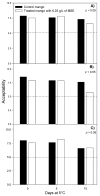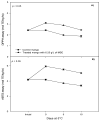Using Sensory Evaluation to Determine the Highest Acceptable Concentration of Mango Seed Extract as Antibacterial and Antioxidant Agent in Fresh-Cut Mango
- PMID: 30061481
- PMCID: PMC6111737
- DOI: 10.3390/foods7080120
Using Sensory Evaluation to Determine the Highest Acceptable Concentration of Mango Seed Extract as Antibacterial and Antioxidant Agent in Fresh-Cut Mango
Abstract
Plant extracts have the potential to be used as food additives; however, their use have been limited by causing undesirable changes in the sensory attributes of foods. We characterized the mango seed extract as a preserving agent for fresh-cut mangoes. We established the maximum concentration of extract that, while increasing the antioxidant activity, and limiting microbial contamination of the fruit, did not negatively affect fruit sensory acceptability. The extract contained 277.4 g gallic acid equivalent (GAE)/kg dw (dry weight) of polyphenols and 143.7 g quercetin equivalent (QE)/kg dw of flavonoids. Antioxidant capacity values were 2034.1 and 4205.7 μmol Trolox equivalent (TE)/g against 2,2-diphenyl-1-picryl-hydrazyl (DPPH) and 2,2'-azino-bis(3-ethylbenzothiazoline-6-sulphonic acid) (ABTS) radicals, respectively. Chromatographic analysis revealed the presence of gallic and chlorogenic acids. The extract (16 g/L) inhibited the growth of Escherichia coli, Salmonella Typhimurium, Staphylococcus aureus and Listeria monocytogenes. The highest concentration with sensory acceptability was 6.25 g/L. At such concentration, the extract preserved fresh-cut fruits, increasing polyphenols (0.427 g GAE/kg fw (fresh weight)), flavonoid content (0.234 g QE/kg fw) and antioxidant activity (DPPH = 2.814 and ABTS = 0.551 mol TE/kg fw). It also reduced inoculated bacteria (range: 5.50 × 10³ to 1.44 × 10⁵ colony forming units (CFU)/g). These results showed the importance of considering consumer acceptability to determine the effective concentration of plant extracts as additives.
Keywords: antimicrobial activity; antioxidant activity; fresh-cut fruit; functional foods; phenolic compounds; sensory attributes.
Conflict of interest statement
The authors declare no conflict of interest.
Figures





References
-
- Ayala-Zavala J., Vega-Vega V., Rosas-Domínguez C., Palafox-Carlos H., Villa-Rodriguez J., Siddiqui M.W., Dávila-Aviña J., González-Aguilar G. Agro-industrial potential of exotic fruit byproducts as a source of food additives. Food Res. Int. 2011;44:1866–1874. doi: 10.1016/j.foodres.2011.02.021. - DOI
-
- Okino Delgado C.H., Fleuri L.F. Orange and mango by-products: Agro-industrial waste as source of bioactive compounds and botanical versus commercial description—A review. Food Rev. Int. 2016;32:1–14. doi: 10.1080/87559129.2015.1041183. - DOI
-
- Vega-Vega V., Silva-Espinoza B.A., Cruz-Valenzuela M.R., Bernal-Mercado A.T., Gonzalez-Aguilar G.A., Ruíz-Cruz S., Moctezuma E., Siddiqui M.W., Ayala-Zavala J.F. Antimicrobial and antioxidant properties of byproduct extracts of mango fruit. J. Appl. Bot. Food Qual. 2013;86:205–211.
-
- Dorta E., González M., Lobo M.G., Sánchez-Moreno C., de Ancos B. Screening of phenolic compounds in by-product extracts from mangoes (Mangifera indica L.) by HPLC-ESI-QTOF-MS and multivariate analysis for use as a food ingredient. Food Res. Int. 2014;57:51–60. doi: 10.1016/j.foodres.2014.01.012. - DOI
LinkOut - more resources
Full Text Sources
Other Literature Sources
Molecular Biology Databases
Miscellaneous

